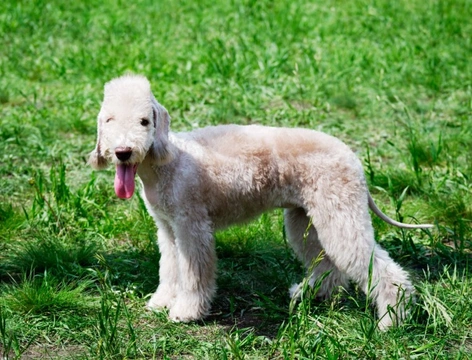
Bedlington Terrier Guide: Temperament, Care & More
The Bedlington terrier is not one of the most common of dog breeds and not everyone may have seen one in the flesh, but these petite and rather lean little dogs are very distinctive-looking and easy to remember once you have seen one, thanks in large part to the shape of their head and the topknot of curly fur that adorns it!
The Bedlington terrier’s appearance means that the breed is also sometimes referred to as the “lamb dogs,” thanks to the shape of their heads and their tightly curled fur. This is one of our native British dog breeds and one that historically used to be used for working purposes, but today they are almost exclusively kept as pets.
This is a versatile breed that contrasts with most of the other small terrier dog types to offer something a little different to prospective puppy buyers, and every year, a whole host of new fans of the breed consider adding a Bedlington to their household.
If you’re wondering if the Bedlington terrier is the right breed of dog for you and you’re beginning to research the breed with a view to buying a Bedlington of your own, this article will tell you ten things you need to know about Bedlington terriers, before you go ahead and pick one. Read on to learn more.
Bedlington terriers need a moderate amount of exercise
The Bedlington terrier is not a sedentary dog breed, and they need a reasonable amount of daily exercise in order to thrive and be happy. However, they are not as challenging to provide with enough exercise as many alternative terrier breeds, and will generally be happy with a couple of 45 minute walks per day that incorporate both on the lead time and off-lead play and socialisation.
Like all terriers, Bedlingtons have a strong prey drive
The Bedlington terrier is a breed that has a very strong prey drive, which was historically harnessed into a working purpose. However, this prey drive can be a problem within a suburban setting, as dogs of the breed may chase cats and pose a danger to other people’s pets.
Always keep a Bedlington on a lead when outside of the home, other than when in dog-safe enclosed spaces.
Bedlington terriers are quite smart dogs
The Bedlington terrier is ranked in 64th position out of a total number of 138 different dog breeds in the Coren ranking of canine intelligence, which places them firmly in the top half of the pack. This means that dogs of the breed are analytical and quite observant, but they do also need a reasonable amount of mental stimulation to keep them from getting bored and unruly.
Bedlington terriers are generally a pleasure to train
Because the Bedlington terrier is a reasonably intelligent dog breed but they’re not right at the top of the canine intelligence list, dogs of the breed tend to be really pleasant to train. They are engaged and interested in training and responsive to commands, and can generally learn and execute a reasonable number of different commands too.
Bedlington terriers tend to be considered as one of the more temperate terrier breeds
Bedlington terriers tend to be more temperate, personable, calm and laid back than most other small terrier breeds, and so provide a great choice for people who love the core terrier personality but find many terrier breeds a little bit too full on!
Bedlington terriers tend to be fairly long lived
The average lifespan of Bedlington terriers in the UK is between around 12-14 years, which is towards the higher end of the average age spectrum for dogs as a species. They tend to be robust dogs that don’t suffer from a huge number of minor ills, despite their small size and fine build.
The breed does have some health challenges, however
That said, like all pedigree dog breeds, there are a handful of hereditary health issues that tend to present in the Bedlington terrier with a higher occurrence rate than is the case for the majority of other dog breeds, and these include a number of eye problems.
Prospective Bedlington terrier buyers are advised to research the breed’s health in detail before shopping around for a puppy, and to choose a pup from a litter whose breeder integrates health testing protocols.
Bedlington terrier coats are high maintenance but low shedding
The Bedlington terrier’s coat is curly and low-shedding, and the fur that they do shed gets trapped in the rest of their coat in the main part. This means that whilst dogs of the breed don’t tend to shed a lot of fur around the home, they do need quite a lot of grooming to keep them in good condition.
Bedlington terriers have a diverse working history
The Bedlington terrier is more or less exclusively kept as a pet and companion today, but historically they have fulfilled a number of roles. Dogs of the breed were originally used to hunt vermin, and they have also been used for dog racing, as well as of course making for great companions!
Bedlington terriers are quite versatile and suit many different types of homes
The Bedlington terrier has a lot to recommend itself as a good pet for many different types of homes and owners; they’re small, reasonably smart, moderate in terms of exercise needs, low shedding, and generally long-lived.
However, they do have a strong prey drive and also require a reasonable amount of mental stimulation, and so needs an engaged owner who understands this and that can provide for all of their needs.



